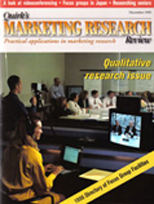Editor's note: Jan Newman is president of The Newman Group, Burlingame, Calif.
No matter how experienced a moderator is in facilitating focus groups or one-on-one interviews, a certain nervous excitement generally precedes discussion. What we must also understand is that respondents may have the same feelings. By paying close attention to the visual language of focus groups - the respondents' facial expressions, body movements and postures - the moderator can learn a great deal about the group's feelings and attention levels. Respondents, in turn, also pick up subtle and not-so-subtle messages from the moderator.
The visual language of a focus group moderator
Attire - One of the most important visual signs is the moderator's dress. Through years of conducting focus groups and one-on-one interviews, I have found that dressing "down" is usually the best approach. Save the latest outfit for another personal occasion and dress like your respondents. The idea behind this action is that you would prefer to have respondents react to you and the questions you pose rather than be so caught up in what you are wearing. Wear only minimal jewelry since you do not want to encourage visual attention to yourself. You want respondents to focus on what you are saying, not what you are wearing.
Depending on the type of focus group or one-on-one interview, dress accordingly. Professional interviews generally suggest a more formal appearance. Check with the field service you are using to learn what the dress norms are for various business sectors match your attire to them.
Body language - Body language is very important in creating a comfortable environment for your respondents. Hands speak. Keep them on the table so people can see how comfortable you are during the conversation. If you are nervous simply hold on to your papers. Hands out of view may signal that you are not comfortable or at ease.
One of the easiest tricks to learn is to lean slightly forward in your chair rather than leaning back. If you lean forward, this suggests that you want to be involved in serious conversation. You are interested and giving someone your full attention. Leaning back in a chair is fine if your respondents are talking among each other since a focus group is really their conversation. When questions are directed at respondents is it generally more productive if the moderator demonstrates visually how interested he or she is in the individual and the entire group.
Eye contact - Eye contact is vital in directing "traffic" in a focus group. With a simple eye movement, a moderator can signal a respondent to share their viewpoint. Eye contact can also cue a respondent to focus more on the meeting at hand and move away from conversation that is secondary or distracting. Eyes show sincerity, empathy and confusion. All of these messages are important in conveying focus group messages.
The respondent's visual language
Body language - The body language of a respondent is a visual clue toward how they are responding to various ideas. If a consumer seems to be quiet, it is the job of the moderator to draw them out of their shell. It is important to recognize that a quiet respondent may be that way due to some level of discomfort with the group format, or they may have an opinion that is vastly different from the majority of the group. In either case, a trained moderator can use their skill to help overcome these obstacles. It is crucial for a moderator to be aware of these visual clues.
A respondent's hands are just as important to look at as their face. The action of the hands speaks to the respondent's mood. Hands can be relaxed, nervous, fidgety, etc. Also pay close attention to the general tone of the facial expressions for the respondents.
Eye contact - Looking a respondent in the eye suggests that they are the individual in the meeting you wish to have speak. By maneuvering your eye contact, one can direct the conversation flow without using any verbal clues. A moderator should be able to recognize excitement, lack of interest, confusion, and understanding of the topics being discussed.
The past and present
I remember some 20 years ago that focus groups were only audio taped. Many of the visual clues used were simply lost except to those who observed the groups. Today, more often than not, the group dynamics are captured on video.
Interviewing in the '90s is also a challenge because many of the questions that once could be directed to an individual may be considered too sensitive or unacceptable. Constant monitoring of the way in which questions are asked of respondents is necessary.
Learn to recognize and utilize the visual language of qualitative research. It will be an invaluable tool in communicating to any size audience, and will help you to achieve a heightened understanding of any interview or meeting agenda.
